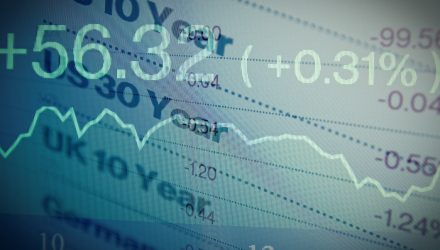Over two decades ago, the Invesco QQQ ETF (NASDAQ: QQQ) was born, but like the exchange-traded fund (ETF) world that conceived it, the space has grown as well.
The Invesco QQQ ETF first hit the markets on March 10, 1999 and has provided a long-standing contribution to investors and provided many with exposure to some of the most innovative companies to rise up over the years. After 20 years, QQQ is now the sixth largest U.S.-listed ETF with over $60 billion in assets under management, was the second most traded ETF in the U.S. based on average daily volume as of the end of 2018 and boasts one of the longest performance histories available for an ETF.
With its holding tilted towards the tech sector, If the space had to nominate an ETF spokesperson to represent the industry, it would no doubt be the QQQ. But, as we’ve seen with the recent market volatility due to tariff-for-tariff tussles between the U.S. and China, there’s also a need for smart beta.
In particular, a product that can capture upside while having downside protection built in during heavy times of volatility. Invesco is certainly seeing the growth in this space with their own ETF products.
“There’s been higher growth in smart beta ETFs than traditional, which has some good reasons behind it,” said Dan Draper, Managing Director, Global Head of Invesco ETFs told ETF Trends. “In general, it shows a lot of the hard work that we’ve been doing for over a decade through education and talking about the benefits of using smart beta to enhance some type of risk-adjusted return optimization in portfolios.”
“What’s really interesting for us now is areas like low volatility, quality, some of these other factor and smart beta solutions we have, we really started re-balancing and we’ve seen really good inflows in that,” Draper added. “So it’s showing us, as we’ve seen in previous market dislocations, it gives an opportunity where not only ETFs grow, but then, especially in our case, smart beta grows as well.”
One of the challenging aspects advisors face with this more cautious investor is the plethora of options available, especially in the ETF space. Where are the opportunities in ETFs given the current market landscape challenged by obstacles such as trade war fears?
One default maneuver is by seeking safe-haven assets, such as bonds. However, investors can also get the smart beta strategies Draper speaks of via fixed-income ETFs.
The Invesco Multi-Factor Defensive Core Fixed Income ETF (CBOE: IMFD) and the Invesco Multi-Factor Income ETF (CBOE: IMFI) are recent additions to the issuer’s lineup of multi-factor bond ETFs. Both new ETFs track in-house indexes.
IMFI follows the Invesco Multi-Factor Income Index. That benchmark “is designed to provide multi-factor exposure to fixed income securities in the following weights: 25% in mortgage-backed securities, 25% higher-quality US investment grade, 25% high yield, and 25% emerging markets debt,” according to Invesco.
Each of the bond market segments represented in the new ETF has its own criteria for assessing quality and value traits, the factors emphasized by the new ETFs. Last year, Invesco also introduced eight multi-factor bond ETFs that focus on favorable value and quality characteristics.
For more market trends, visit ETF Trends.

